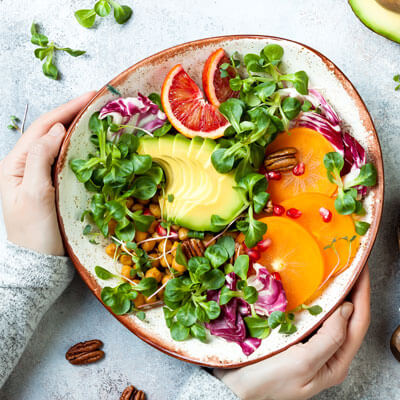 By Dr. Deepa Patel
By Dr. Deepa Patel
Superfoods are foods such as fruits and vegetables that provide us with a large amount of nutrients that go beyond just carbohydrates, proteins, and fats. It is important to remember that not one specific food alone can provide you all the nutrients you need to keep your body moving and functioning optimally. The concept of “Eating the Rainbow” is a great analogy to think about when food shopping, as it will help you make healthier choices.
See the list below for my favorite superfoods and some of their benefits. I strongly encourage you to try these different foods if you haven’t already incorporated them into your diet. Expanding out of your comfort zone can seem a bit nerve-wracking, but to make it easier I’ve included a few ways to incorporate these different superfoods into your diet.
How to Include Superfoods Into Your Diet
- Berries. High in fiber, berries are naturally sweet, and their rich colors mean they are high in antioxidants and disease-fighting nutrients. Anti-inflammatory properties are huge in helping us get out of pain as well as remaining pain free! When berries are not in season, buy them frozen. Add to yogurt, cereals, and smoothies, or eat plain for a snack. When buying frozen, make sure to read the labels to avoid added sugar. Organic is always the best option.
- Fish. Fish can be a good source of protein and omega-3 fatty acids, which help prevent heart disease. Buy fresh, frozen, or canned fish. Fish with the highest omega-3 content are salmon, tuna steaks, mackerel, herring, trout, anchovies, and sardines. When buying canned fish, such as tuna make sure to look into the sodium content as well as packaging without BPA .
- Leafy greens. Dark, leafy greens are a good source of vitamin A, vitamin C, and calcium, as well as several phytochemicals (chemicals made by plants that have a positive effect on your health). They also add fiber into the diet. Try varieties such as spinach, swiss chard, kale, collard greens, or mustard greens. Throw them into salads or sauté them in a little olive oil. You can also add greens to soups and stews. If you have an air fryer, try making kale chips! Sprinkle a pinch of himalayan pink salt and drizzle with cold press extra virgin olive oil for extra flavor.
- Nuts. Hazelnuts, walnuts, almonds, pecans are a good source of plant protein. They also contain monounsaturated fats, which may be a factor in reducing the risk of heart disease. Look for raw or roasted, whatever your preference, but choose unsalted or lightly salted. Add a handful to oatmeal or yogurt or have as a snack. But remember they are calorically dense, so limit to a small handful. Try the various types of nut butters such as peanut (technically a legume), almond, or cashew. Nuts are also a great accompaniment to cooked veggies or salads.
- Olive oil. Olive oil is a good source of vitamin E, polyphenols, and monounsaturated fatty acids, all which help reduce the risk of heart disease. Use in place of butter or margarine in pasta or rice dishes. Drizzle over vegetables, use as a dressing, or when sautéing. When buying olive oil it’s important to look for cold pressed olive oil in a dark bottle, this is the best kind for you as it helps maintain the nutritional value.
- Whole grains. A good source of both soluble and insoluble fiber, whole grains also contain several B vitamins, minerals, and phytonutrients. They have been shown to lower cholesterol and protect against heart disease and diabetes. Try having a bowl of steel cut oats oatmeal for breakfast. Substitute bulgur, quinoa, wheat berries, or brown rice for your usual baked potato. You can even add these grains into your salads!
- Yogurt. A good source of calcium and protein, yogurt also contains live cultures called probiotics. These “good bacteria” help keep your gut healthy. Be sure to use organic as much as possible and avoid yogurt with added sugars, artificial colors, and flavors. Try eating more yogurt, but watch out for fruited or flavored yogurts, which contain a lot of added sugar. Buy plain yogurt and add your own fruit. Look for yogurts that have “live active cultures” such as Lactobacillus, L. acidophilus, L. bulgaricus, and S. thermophilus. You can use yogurt in place of mayonnaise or sour cream in dips or sauces.
- Cruciferous vegetables. These include broccoli, Brussels sprouts, cabbage, cauliflower, collard greens, kale, kohlrabi, mustard greens, radishes, and turnips. They are an excellent source of fiber, vitamins, and phytochemicals including indoles, thiocyanates, and nitriles, which may prevent some types of cancer. Steam or stir-fry, adding healthy oils and herbs and seasonings for flavor. Try adding a frozen cruciferous vegetable medley to soups, casseroles, and pasta dishes.
- Legumes. This broad category includes kidney, black, red, and garbanzo beans, and peas. Legumes are an excellent source of fiber, folate, and plant-based protein. Studies show they can help reduce the risk of heart disease. Add to salads, soups, and casseroles. Make a chili or a bean- based spread such as hummus.
- Tomatoes. These are high in vitamin C and lycopene, which has been shown to reduce the risk of prostate cancer. Try tomatoes in a salad or as a tomato sauce over your pasta. You can also put them in stews, soups, or chili. Lycopene becomes more available for your body to use when tomatoes are prepared and heated in a healthy fat such as olive oil. Use a ketchup that contains no added sugar or high fructose corn syrup.
